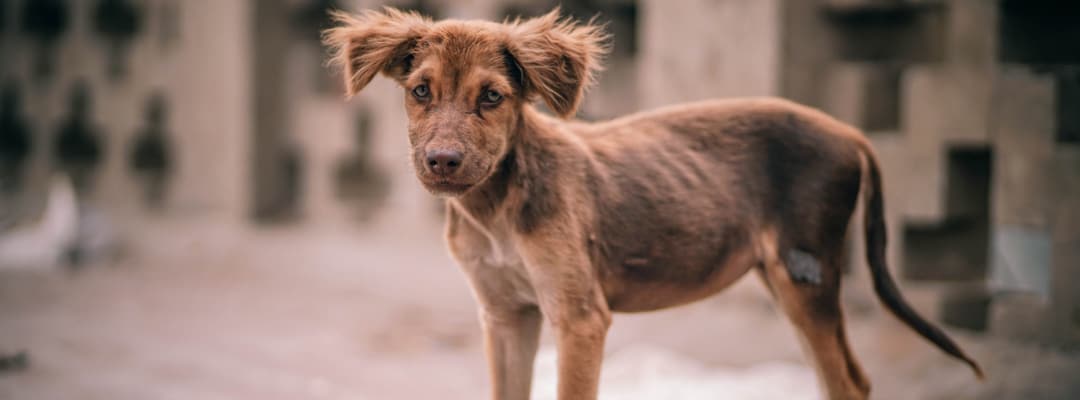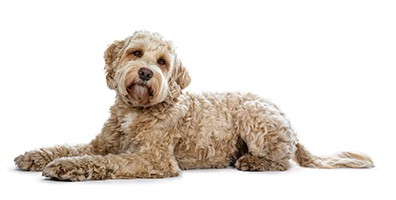Contrary to what many people believe, malnourishment is not a condition unique to stray or abandoned dogs. The condition can also sneak up on dogs that live with a loving family and are well cared for.
Sometimes, people who suspect that their dog may be malnourished are hesitant to seek help, fearing that they might be viewed as an animal abuser or at the very least, guilty of neglect. While this may not be the case at all, the stigma associated with malnutrition stops them in their tracks.
There is no shame in seeking help for a dog who is suffering from nutritional deficiencies. In fact, it is absolutely the right thing to do.
Signs That a Dog Is Malnourished
Most people are familiar with the usual sign of malnutrition, emaciation. We’ve all seen the graphic images of dogs so weak from hunger that they can barely take one step, and they appear to be nothing but skin and bones.
While severe emaciation is indeed a manifestation of malnutrition, it’s just one of many indicators that point to a lack of proper nutrition. Let’s look at the other, lesser-known signs that your dog isn’t receiving an adequate amount of daily nutrients. Remember, knowledge is power, so read on.
Weakness and Lethargy
Dogs who are undernourished often appear noticeably weaker than usual. A normally playful, rambunctious dog may begin to lag behind on walks and become disinterested in activities that once delighted him.
In fact, a general lack of interest in life and even depression are often seen in malnourished dogs. They don’t have the strength to enjoy life as they once did. This is because their bodies are lacking the resources they need to function optimally.
Anemia is another common sign of an inadequate diet and will compound the problem of weakness and lethargy in malnourished dogs.
Skin Disorders
As is true of people, a dog’s skin is the largest organ of the body and is often where signs of illness are first noticed.
Itchy, scaly, or flaky skin is often an indicator of insufficient nutrient levels. Red, irritated areas are also commonly seen with nutritional imbalances.
The increase of scratching that occurs with dry or irritated skin may lead to secondary infections. Symptoms of infection include:
- Skin that is hot to the touch.
- Oozing or weeping areas.
- Foul odor.
- Crusting, scabs, or blisters,
- Angry looking red areas.
- Pustules.
- Swelling or raised lesions.
Dull, Slow Growing Coat
You may notice a marked change in the appearance of a malnourished dog’s coat. Fur that was once shiny, lush, thick, and healthy-looking may become dry, sparse, and dull.
Patches of hair loss may appear as well. In addition, though not as common, portions of the coat may even undergo a change of color, giving the dog a washed-out, drab look.
Following a seasonal shed, the coat may take longer than normal to fill out again, leaving the dog with a perpetually ragged appearance. If any hair loss for other reasons has occurred, bald patches may linger for a long time before filling in.
Frequent Illness and Long Recovery Period
Malnourished dogs have a difficult time fighting off infections and illnesses that healthy dogs typically bounce back from quickly. Sickness may linger or continue to reoccur as the body’s weakened immune system tries to keep up but often falls short.
The recovery period from illness, injury, or surgery may be a long, drawn-out process. With limited nutrient reserves, the body is unable to heal and repair itself efficiently as it normally would if the dog were healthy.
Change in Bowel Habits
Constipation, diarrhea, or inconsistent bowel movements are another sign that your dog’s body may not be receiving the nourishment it needs. Incomplete or improper digestion robs the dog of nutrients that otherwise would have been absorbed and utilized in the body.
A lack of proper nutrients throws normal bodily functions out of sync, so while it may not be pleasant for you, it is important to routinely monitor your dog’s bowel habits to learn what is normal and what is not.
Foul Breath
Bad breath can result from a variety of reasons, but it may be an indication that there is a nutritional deficiency lurking internally. However, bad breath can also be caused by decay within the mouth which can make eating very uncomfortable for the dog causing him to not consume enough food or stop eating entirely. So, bad breath can not only be a sign of malnutrition but could actually point to the cause of malnutrition.
How to Put Weight on a Malnourished Dog (and Gain Muscle Mass)
When most people the words, “malnourished dog,” images of starved, abandoned dogs spring to mind, and indeed the leading cause of malnutrition in dogs is lack of food. There are, however, many other factors that can contribute to malnutrition, some of which may surprise you.
- Parasites – Internal parasites such as hookworms, roundworms, and tapeworms live in a dog’s intestinal tract and deprive the dog’s body of much-needed nutrients. External parasites such as fleas and ticks feed on the dog’s blood and can cause anemia if present in large enough numbers.
- A low-quality diet – A diet consisting of table scraps or a cheaply made commercial food is highly unlikely to meet a dog’s daily nutritional requirements. Low-quality dog food is often loaded with fillers, has low amounts of protein and fats, and nutrient ratios that are not ideal for maximum absorption.
- Health issues – Kidney or liver disease, thyroid disorders, diabetes, cancer, dental conditions, and inflammatory bowel disease are just some of the internal conditions which can cause a dog to become malnourished.
Visit Your Veterinarian
This is the first and most critical step for getting your dog on the road to recovery. Since so many factors can lead to malnutrition, a correct diagnosis of what is actually causing the weight loss is vital – something only a veterinarian is capable of providing.
Once the problem has been identified, treatment and recovery can begin. Until then, any efforts on your part to put weight on your dog may be fruitless.
Frequent, Small Meals is Best for Boosting Weight
While you may be tempted to feed your dog large quantities of food to help him pack on weight quickly, this is not recommended. His fragile system won’t be able to handle large meals, and counterproductive vomiting or diarrhea may result.
Large quantities of food can also lead to a condition known as refeeding syndrome. This occurs when a nutrient deficient or starving dog’s body develops severe fluid, nutrient, and electrolyte imbalances when suddenly given too much food. Organ damage and even death can occur, so keep the meals small at first while your dog is recovering.
Puppy Food for Adding Weight
A malnourished dog not only loses fat but muscle mass as well as his body utilizes all available nutrients to survive. Puppy food usually contains higher amounts of easily digestible protein and fat, both of which your dog will benefit from.
Diamond puppy food for weight gain, for example, contains 31% protein and 20% fat. Blue Buffalo Wilderness Puppy Food is another great option containing 36% protein and 16% fat and is made with natural ingredients. Hill’s Science Diet also has a puppy food that is rich in proteins and fats.
High-Performance Food For All Ages
Dog food created for athletic, active, or working dogs typically contains larger amounts of nutrients and higher levels of protein and fat than ordinary dog food. The better quality and greater quantity of available nourishment found in high-performance food can help your malnourished or underweight dog bounce back to peak physical condition.
Purina Pro Plan Sport dog food features chicken or salmon as the most abundant ingredient, contains 30% protein and 20% fat, and provides 496 calories per cup. Ideal for puppies and adults, this complete feed is rich in antioxidants to boost the immune system and amino acids to nourish the muscles.
Bully Max High-Performance dog food is an all-natural, complete feed with an impressive 535 calories per cup. Full of wholesome ingredients like chicken, brown rice, chicken fat, barley, flaxseed, egg, and fish meal, this feed also boasts a 30% protein and 20% fat content.
Add Extra “Goodies”
To provide bonus nutrients to your dog’s small meals, try adding a tablespoon or two of peanut butter or a boiled egg. Some high carbohydrate foods like cooked oatmeal, brown rice, or sweet potatoes can also help him gain weight.
If you’re not already mixing in some canned food to the kibble, this can be a great way to add some additional protein and fat to your dog’s diet or entice finicky eaters to finish their meal as most dogs can’t resist the flavor of canned food. Purina One Smartblend True Instinct is a highly digestible, grain-free option with no artificial preservatives, colors, or flavors.
Provide Weight-Gaining Supplements
Your goal shouldn’t be to rapidly put weight on your dog in the form of fat. Rather, you should strive to nurse your dog slowly back to health by providing all of the nutritional requirements his body needs to restore overall well-being and regain muscle mass.
Nutritional supplements for dogs come in many forms and offer your dog a much-needed boost in calories, vitamins, and minerals as his body gradually replace what was lost due to malnutrition.
Tomlyn’s Nutri Cal is a high-calorie gel formulated by veterinarians and fortified with omega fatty acids, vitamins, and minerals.
Buddy and Lola Weight Gainer is a powdered supplement containing 29% protein and 43% healthy fat that can be sprinkled over your dog’s food. This product is designed to improve the skin and coat, build up healthy muscle, increase energy levels, and add weight – all of which can benefit a malnourished dog.
Dyne High-Calorie Supplement is a liquid supplement to be poured directly over food. Though low in protein (1.9%), this product has a whopping 150 calories per ounce and 48.3% fat to aid in weight gain and restore energy levels.
Myos Canine Muscle Formula is a powdered supplement that contains only one ingredient – fertilized egg yolk. It is clinically proven to support muscle growth and strength while supplying essential amino acids, vitamins, and minerals for improved overall health.
Your malnourished dog may also benefit from a high quality multi-purpose vitamin-like Pet Honesty 10 For 1 Multivitamin. This blend comes in a soft chewable and contains a wide array of vitamins, minerals, fatty acids, and probiotics to improve your dog’s digestion, skin and coat, joint function, and immune system.
Bully Max Muscle Builder Combo includes Bully Max tablets which consist of 19 muscle building ingredients and Gorilla Max powder which contains 70% protein and a long list of essential nutrients. Made with all-natural ingredients and no steroids, this nutrient-rich combo pack is ideal for helping malnourished dogs regain bulk and strength.
Exercise (putting on lean muscle)
Unless your dog is too weak to exert himself at all, regular exercise should be a part of his routine. At first, this may sound counterproductive, but exercise has two important benefits for malnourished dogs.
- Exercise helps to develop healthy, lean muscle while reducing the risk of gaining too much body fat. Remember, your goal is a healthy dog, not an obese one.
- Exercise will also increase your dog’s appetite so that he’ll quickly wolf down all those healthy little meals you’re offering him.
Recap: Adding Weight to a Skinny Dog
Following a veterinary exam and appropriate medical treatment, if needed, a feeding program should be implemented right away to help a malnourished dog regain strength, weight, and muscle. There are many different foods and supplements that can be added to your dog’s diet to boost weight and muscle mass.
Offering small meals frequently throughout the day is considered to be the best course of action. Putting weight back on a malnourished dog is not something that will happen overnight, but with patience and dedication on your part, it will happen over time, and your dog will thank you for it.





